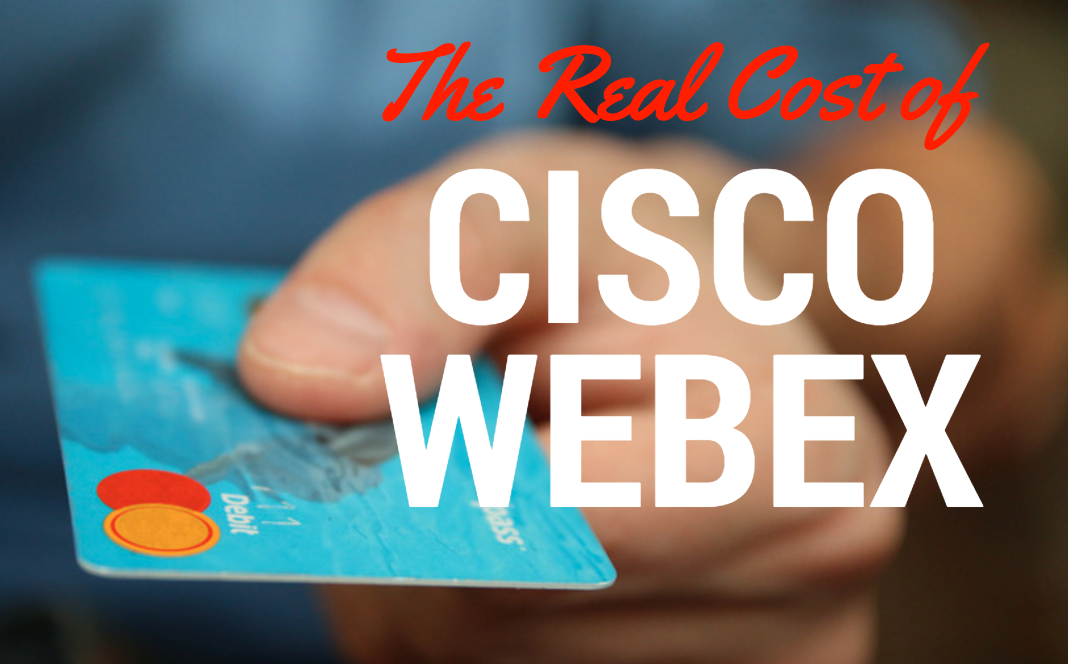
How much does Cisco Webex cost in 2019?
The first thing to know is that the cost of Cisco Webex has dropped from $89/user to $29 over the last year, and our sources say that $30/user/month is pretty much the upper limit for business purchases these days. That’s a solid deal, especially if you choose to take the Active User path for your first year. You can save a bundle over competition.

Cisco WebEx is a big deal in the collaboration world, but there’s still questions and uncertainty around how much how much Cisco WebEx actually costs each year. We posted this article regarding the real cost of Cisco WebEx and we’ve seen it generate tons of page views, social shares, and partner interest over the past few years.
However, this industry is moving fast and a lot has changed, even with WebEx pricing. Here are the latest and greatest updates and changes to the operational costs of Cisco WebEx as a video conferencing solution.
We’ll cover:
- A three part cost breakdown
- New pricing
- Competitive product updates
- Updates to CMR Integration Costs (It’s FREE)
- Updates to Audio types
- Total Cisco WebEx Cost Breakdown examples
The Three Costs of Cisco WebEx
There are three major components to Cisco WebEx pricing to be aware of:
COST #1: USER (HOST) LICENSES
There are three ways to structure your licensing purchase:
- Named Users: Use this model to know exactly who will be needing a video conferencing license. Typically this is pretty great for smaller company (<200 users).
- Active Users: This option seems to tailor to larger companies. By selecting the active user option, you will only be charged for the average number of users who host a meeting within a month-long timeframe. According to Cisco, this is the best place for a new company to start with WebEx, because you can pay for only 15% of your total user base for A YEAR, even if more than half your users become active users in that time. This is a gigantic savings, and is something that no other vendor besides Cisco can offer. In the second year, Cisco will “true forward” based on the average # of active users in months 8-9-10 of your contract.
- Enterprise License: If more than 40% of your users are “Active” in that they host a meeting at least once a month, it makes more sense to go to an Enterprise model because the per user cost is lower. Simply sync with Active Directory to give every user the ability to host a WebEx meeting, whether they want to use it or not. Provisioning is now in their hands instead of yours!
PRO TIP: User licenses averages 50% or less of the total WebEx costs!
Image Below: Cisco WebEx’s Pricing Page
COST #2: AUDIO
I bet you thought this was included in the user licensing, didn’t you? In some cases, this is true. The “audio costs” that come free are VOIP minutes, AKA when you click “Call with my Computer” after you join a meeting. There are also a couple other options, including Toll, Toll Free, and Callback minutes. All of these have costs associated with them, but you can buy them in various ways. In all cases, international minutes are subject to a complex rate table and also cost the most. There are three sources for Audio that you can select from:
- WebEx Audio: You can buy these minutes in chunks or you can pay as you go. This is a purchase from Cisco, and can often be bundled in with your licensing.
- Cisco Cloud Connected Audio (CCA): This is a relatively new model, and is especially attractive to customers using the Enterprise License model above. The cost per minute is very low because basically, all traffic becomes VoIP over Cisco’s global network. It’s the future!
- Third Party: This audio really depends on your reseller/ISP relationship, and can be the most cost-effective of the bunch. You basically separate your audio from your WebEx licensing and purchase from the reseller network. It can be a mix of traditional telephony and VoIP traffic as well.
COST #3: STORAGE
In case you weren’t aware, Cisco WebEx sessions are recorded in a proprietary format and are considered “included” storage that comes with each user license (2.5GB). This makes sense overall. However, this structure could have negative benefits if you expand beyond your amount of allocated space. Storage can get pricey if you want to have access to webinars or meetings for later use, and the WebEx format is not the most efficient at compression.
How WebEx is Staying Competitive
It’s obvious Cisco is paying attention to the market and their competition. By reducing pricing they can remain competitive against fully integrated vendors like HighFive, BlueJeans, GoToMeeting, HipChat, Fuze, Zoom, and so on. Yet, being a cost-effective solution, doesn’t mean end-users will actually use the technology.
To keep up with the market, WebEx is now integrated into the Cisco Spark offering, and licensing has been even further simplified if you purchase Spark user licenses. This means that once you purchase a Spark license to get persistent chat, calling, video, mobile, and you get multi-party meetings (AKA WebEx Meeting Center) thrown in! It’s a tremendous deal, and Spark is only becoming more useful as time goes on and more integrations are made. Personally, we just added the G Suite calendaring integration with our WebEx Personal Meeting Rooms, and now every meeting is accessible through a single click from my mobile or laptop. It’s the ideal experience.
In an effort to keep up with new, fully integrated video conferencing solutions, Cisco WebEx has launched a ton of new updates. They’ve rejuvenated their look and feel, added loads of new features (that users love), and have scaled overall performance. They are able to serve an infinite amount of customers.
Finally, if you haven’t been tuning in, WebEx has been winning a lot of awards lately. We applaud you, Cisco.
Webex Enterprise Feature Updates
A couple years ago, Cisco launched the ability to join WebEx meetings via video conferencing rooms. At first, this was an expensive integration. Now it is free. That is a big deal. For example, competitors like Zoom and BlueJeans charge $50/month/room for this capability. Our average customer has over 100 rooms that they have acquired over several years. Of course, you still have to pay to register rooms to a Cisco system like UC Manager, but that is a different story for a different day.
Now, for the updated numerical analysis you came for!

*Note: I am not going guess the volume discount for Cisco (contact them directly), so I’ve included the full list price above. It’s quite likely you’ll be charged less.
USER LICENSES:
Ok, let’s say you have 5,000 employees, and you want enough host licenses so that you don’t run out during busy days. We know that, failing to have a meeting due to lack of technical resources is worse for your business than spending a few extra dollars per month. So, my advice (and your salesperson’s advice) should be to go with an Active User model. Your starting price will be 15% of 5000, or 750 users at a max of $30/month.
So, 750 x $30 = $22,500/month licensing
AUDIO MINUTES:
If you have 5000 employees that are in one WebEx meeting per day (on average), means you have 5000 x 1 hour per day x 5 days x 4 weeks, that means you’ll need 100,000 hours of audio per month. This means you’ll need 6,000,000 minutes per month for internal only.
Now, let’s just say, 50% of those audio minutes are used for external lines (non-VoIP). In addition, there is 1 customer on every other hour of meetings. This means you’ll be charged for their call in time to your meetings.
So, 3,000,000 (non-VoIP internal) + 3,000,000 (customer non-VoIP) x .02 = $120,000 per month in audio costs
STORAGE COSTS:
Now, we know each WebEx account comes with some recording capabilities, but you are also charged for storage (unless you have an internal media storage solution). This information is slightly tougher to get, but we dug in here for you.
If WebEx $7.20/GB, and we were able to find that 50GB is minimum total for network-based recording.
Knowing this, let’s say your users don’t record often. For number’s sake lets say, 1/100 WebEx hours are being recorded at your company. That equates to 1000 hours, which is about 250 GB of storage for video. To keep it simple, let’s focus on a one year period. This leaves us with 250GB x 12/mo.
That final equation would be, $7.20 x 250 x 12 = $21,600 in storage costs per month
Total Cisco WebEx Cost Breakdown
So, to sum things up, here is our cost breakdown for Cisco WebEx:
- Licensing: $22,500
- Audio: $120,000
- Storage: $21,600
The total WebEx cost of $144,100/mo. or $1,729,200/year.
Of course, you’ll want to remember that there are significant volume discounts. Plus, all previous negotiations should be taken into account. Either way, it’s a significant investment to your business and you’ll want to ensure you’re spending this investment wisely.
As part of our response to the COVID-19 pandemic, Vyopta is currently offering a free trial to help IT teams monitor Cisco Webex and other platforms such as Zoom, Microsoft Teams, BlueJeans and more as well as support a massive expansion in remote work.

.png?width=525&name=cta-benchmark-uc-env%20(1).png)



